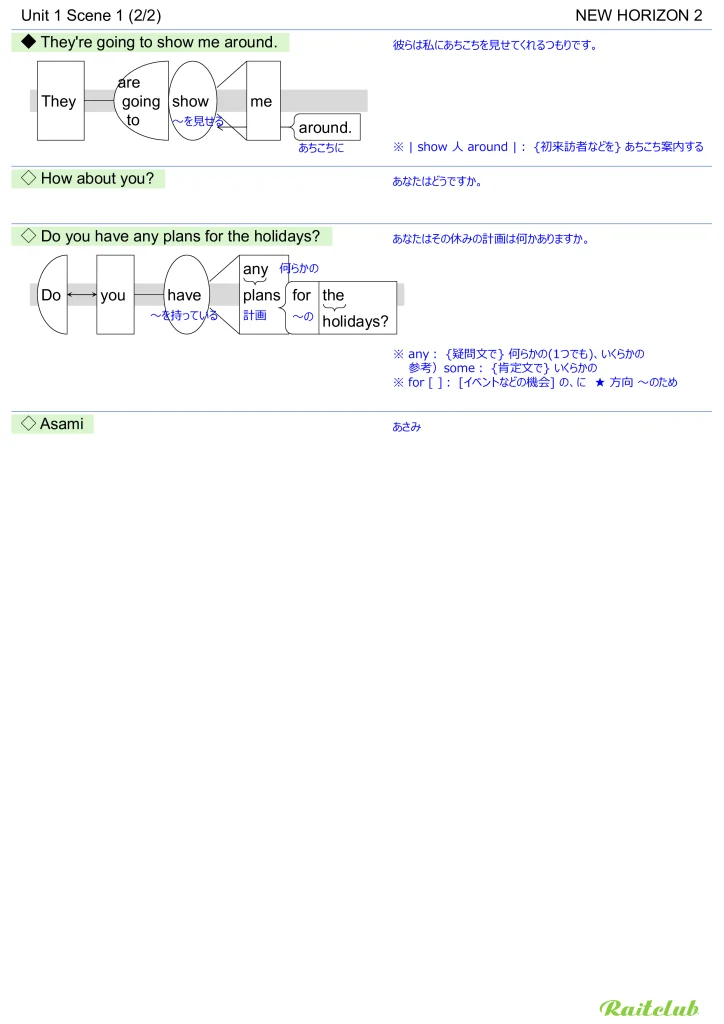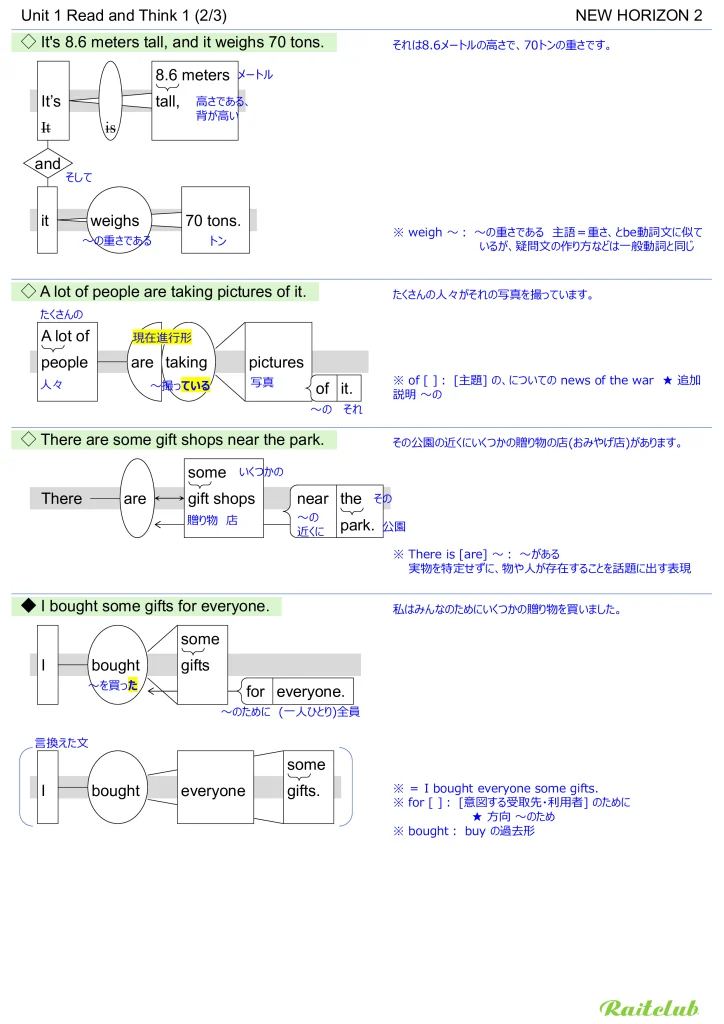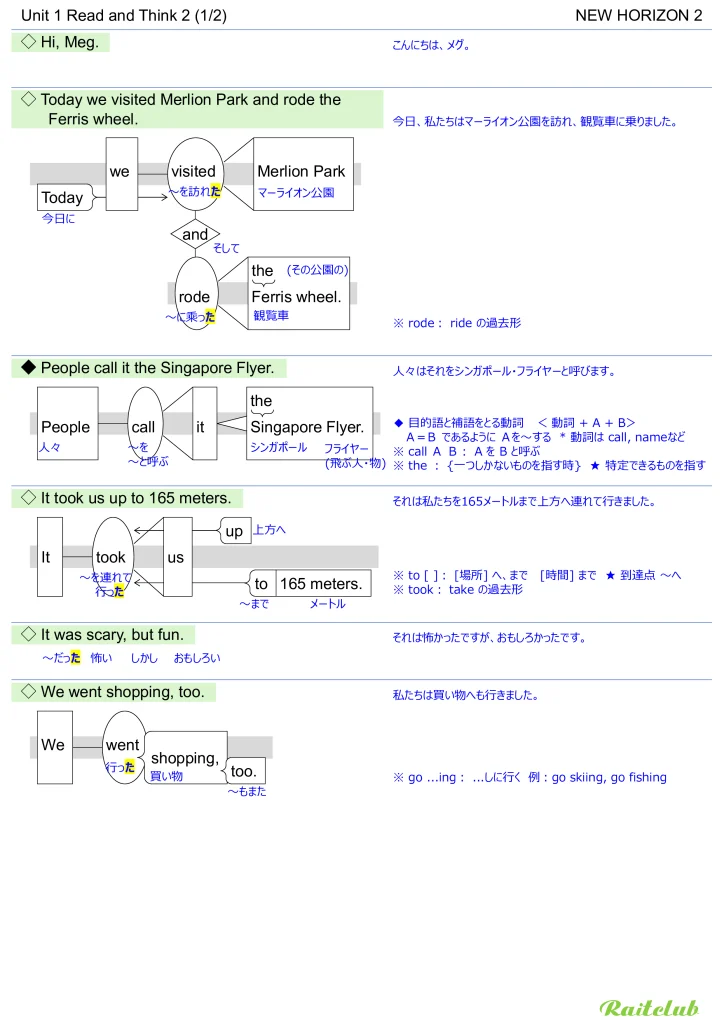中学2年生教科書 New Horizon 2 (ニューホライズン 2年) Unit 1: A Trip to Singapore の重要文法と、本文・和訳・英文見える化チャートです。
英文見える化チャートは、英語の「意味理解」を視覚的にサポートするツールです。習得を促進する音声付きです。音読活動などで活用することで英語を身に着けるのを支援します。
ポイント解説付きなので、定期テスト対策として、単語の意味・用法や、文法・文構造の確認にも使えます。
なおこのページでは英語のみの音声も聞けます。リスニングやシャドウイングなどでお使いいただけます。
重要文法
be going to < be going to + 動詞の原形>
{意向・計画} ~するつもりです
➡ I am going to visit Tokyo.
問:Are you going to visit Tokyo?
答:Yes, I am. [No, I am not.]
助動詞 will < will + 動詞の原形>
{未来のことを言う} ~します、~でしょう
*確実なこと、予測、意向(その場で決めた) など
➡ You will see Mt. Fuji soon.
目的語を2つとる動詞 < 動詞 + (人) + (物)>
(人) に (物) を ~する
*動詞はshow, give, buy, teachなど
➡ I will give you these cookies.
目的語と補語をとる動詞 < 動詞 + A + B>
A=BであるようにAを ~する
*動詞は call, nameなど
➡ Please call me Meg.
本文・和訳・チャート
音声リスト
※ バックグラウンド再生もできます
以下の各パート内の音声は速度調整や個別にループ再生もできます
Unit 1 Scene 1
◇ Hi, Josh.
こんにちは、ジョシュ。
◇ Guess what?
あのね。
※ guess what: 人を驚かすことを言う前に使う
※ guess: {正しいかわからないが} 答えを当てようとする
◆ I’m going to visit Singapore during the “Golden Week” holidays.
私はゴールデンウィークの休みの間にシンガポールを訪れるつもりです。
◆ be going to < be going to + 動詞の原形>
〇 {意向・計画} ~するつもりです
他に〇 {未来の予測(ほぼ確実、根拠あり} ~でしょう
◇ It’s my first trip abroad.
それは私の初めての外国旅行です。
※ abroad: 外国へ *時・場所の副詞は名詞を修飾することも on my way home
◇ I’m so excited.
私はとてもわくわくしています。
◆ I’m going to stay with my aunt and her husband.
私は私のおばと彼女の夫と一緒に滞在するつもりです。
◆ They’re going to show me around.
彼らは私にあちこちを見せてくれるつもりです。
※ | show 人 around |: {初来訪者などを} あちこち案内する
◇ How about you?
あなたはどうですか。
◇ Do you have any plans for the holidays?
あなたはその休みの計画は何かありますか。
※ any: {疑問文で} 何らかの(1つでも)、いくらかの
参考)some: {肯定文で} いくらかの※ for [ ]: [イベントなどの機会] の、に ★ 方向 ~のため
◇ Asami
あさみ
音声(英語/習得用)
| ♪ 英語の音声: | |
| 1回再生 | |
|---|---|
| ループ再生 | |
| ♪ 習得用の音声(英⇒日を区切りごと): | |
| 1回再生 | |
|---|---|
| ループ再生 | |
英文見える化チャート 1/2

英文見える化チャート 2/2

Unit 1 Scene 2
◇ What are we going to do today?
今日、私たちは何をするつもりですか。
◇ First, we’re going to visit Merlion Park.
まず、私たちはマーライオン公園を訪れる予定です。
◇ Is the park far from here?
その公園はここから遠いですか。
◇ No, it’s not.
いいえ、そうではありません。
◆ You’ll see the Merlion soon.
あなたはすぐにマーライオンを見るでしょう。
◆ 助動詞 will < will + 動詞の原形>
〇 {未来*のことを言う時} ~します、~でしょう
* 確実なこと、予測、意向(その場で決めた) など
他に〇 {やる気・意欲} ~します、{依頼・命令} など
※ you’ll: you will の短縮形
◇ I can’t wait.
私は待つことができません。 → 待ちきれません。
◇ After that, we’re going to have lunch.
その後で、私たちは昼食をとるつもりです。
◇ What do you want to eat?
あなたは何を食べたいですか。
◇ Seafood or chicken rice?
シーフード、それともチキンライス?
◇ I want to eat seafood.
私はシーフードを食べたいです。
◆ OK. I’ll make a reservation.
わかりました。 私がレストランを予約します。
※ I’ll: I will の短縮形
※ make [ ]: [mistake, reservation などの名詞] をする
音声(英語/習得用)
| ♪ 英語の音声: | |
| 1回再生 | |
|---|---|
| ループ再生 | |
| ♪ 習得用の音声(英⇒日を区切りごと): | |
| 1回再生 | |
|---|---|
| ループ再生 | |
英文見える化チャート 1/2

英文見える化チャート 2/2

Unit 1 Read and Think 1
◇ Hi, Josh. Look.
こんにちは、ジョシュ。 見てください。
◇ We’re now in Merlion Park.
私たちは今マーライオン公園にいます。
◆ I’ll show you the Merlion.
私はあなたにマーライオンを見せます。
◆ 目的語を2つとる動詞 < 動詞 + (人) + (物)>
(人)に(物)を~する * 動詞は show, give, buy, teachなど
< 動詞 + (物) + to/for (人)> も同じ意味
* to/forは動詞による
※ = I’ll show the Merlion to you.
◇ It’s a symbol of Singapore.
それはシンガポールのシンボルです。
※ a: {人・物(単体)の一般名・種類を言う時} He’s a doctor. ★ 実物を特定しない単体を指す
※ of [ ]: [(部分などの)帰属先・関係先] の ★ 追加説明 ~の
◇ “Mer” means “sea.”
「マー」は「海」を意味します。
◇ The Merlion has the body of a fish and the head of a lion.
マーライオンは魚の体とライオンの頭を持っています。
※ the : {人の体の一部を指す時} {文脈・状況から皆が特定できるものを指す時} その~ ★ 特定できるものを指す
◇ It’s 8.6 meters tall, and it weighs 70 tons.
それは8.6メートルの高さで、70トンの重さです。
※ weigh ~: ~の重さである 主語=重さ、とbe動詞文に似ているが、疑問文の作り方などは一般動詞と同じ
◇ A lot of people are taking pictures of it.
たくさんの人々がそれの写真を撮っています。
※ of [ ]: [主題] の、についての news of the war ★ 追加説明 ~の
◇ There are some gift shops near the park.
その公園の近くにいくつかの贈り物の店(おみやげ店)があります。
※ There is [are] ~: ~がある
実物を特定せずに、物や人が存在することを話題に出す表現
◆ I bought some gifts for everyone.
私はみんなのためにいくつかの贈り物を買いました。
※ = I bought everyone some gifts.
※ for [ ]: [意図する受取先・利用者] のために ★ 方向 ~のため
※ bought: buy の過去形
◆ I’ll give you these Merlion cookies, Josh.
私はあなたにこれらのマーライオンのクッキーをあげます、ジョシュ。
※ = I’ll give these Merlion cookies to you, Josh.
※ to [ ]: [受取先/見・聞かされる先] へ ★ 到達点 ~へ
◇ Can you see that Ferris wheel?
あなたはあの観覧車が見えますか。
◇ We’re going to ride it after lunch.
私たちは昼食後にそれに乗るつもりです。
音声(英語/習得用)
| ♪ 英語の音声: | |
| 1回再生 | |
|---|---|
| ループ再生 | |
| ♪ 習得用の音声(英⇒日を区切りごと): | |
| 1回再生 | |
|---|---|
| ループ再生 | |
英文見える化チャート 1/3

英文見える化チャート 2/3

英文見える化チャート 3/3

Unit 1 Read and Think 2
◇ Hi, Meg.
こんにちは、メグ。
◇ Today we visited Merlion Park and rode the Ferris wheel.
今日、私たちはマーライオン公園を訪れ、観覧車に乗りました。
※ rode: ride の過去形
◆ People call it the Singapore Flyer.
人々はそれをシンガポール・フライヤーと呼びます。
◆ 目的語と補語をとる動詞 < 動詞 + A + B>
A=B であるように Aを~する
* 動詞は call, nameなど
※ call A B: A を B と呼ぶ
※ the : {一つしかないものを指す時} ★ 特定できるものを指す
◇ It took us up to 165 meters.
それは私たちを165メートルまで上方へ連れて行きました。
※ to [ ]: [場所] へ、まで [時間] まで ★ 到達点 ~へ
※ took: take の過去形
◇ It was scary, but fun.
それは怖かったですが、おもしろかったです。
◇ We went shopping, too.
私たちは買い物へも行きました。
※ go …ing: …しに行く 例:go skiing, go fishing
◇ I found four different languages on Singapore money—Malay, Chinese, Tamil, and English.
私はシンガポールの通貨の上に4つの異なる言語ーマレー語、中国語、タミル語、英語、を見つけました
※ —(ダッシュ)は長い同格などを導く時に使う
※ on [ ]: [物/地形など] の上に、表面に(接触して) ★ 接触
※ found: find の過去形
◇ People in Singapore speak different languages.
シンガポールの人々は異なる(さまざまな)言語を話します。
※ in [ ]: [場所] で、の中で [所属先/会員となっている先] の一員で in Class 1B ★ ~の中
◇ My uncle speaks Tamil and English, so I can communicate with him.
私のおじはタミル語と英語を話します、なので私は彼とコミュニケーション(意思疎通)することができます。
※ with [ ]: [同伴者・物] といっしょに [活動に含まれる他の対象物] を相手に、に対して fight with my brother ★ 付帯 ~といっしょに
◇ Overseas trips are very interesting.
海外旅行はとても興味を起こさせます(おもしろいです)。
◇ We can experience different languages and cultures.
私たちは異なる言語や文化を経験することができます。
◇ Asami
あさみ
音声(英語/習得用)
| ♪ 英語の音声: | |
| 1回再生 | |
|---|---|
| ループ再生 | |
| ♪ 習得用の音声(英⇒日を区切りごと): | |
| 1回再生 | |
|---|---|
| ループ再生 | |
英文見える化チャート 1/2

英文見える化チャート 2/2


